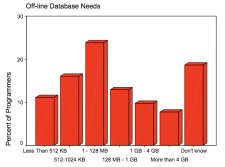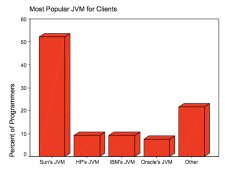Wireless development resisting recession
Jan 28, 2009 — by LinuxDevices Staff — from the LinuxDevices Archive — 1 views Despite the turbulent economy, enterprises have no intention of cutting back on their wireless applications development, a new report says. However, Microsoft's Windows Mobile and .NET Compact Framework technologies are preferred to Apple's iPhone and Google's Android by a significant margin, according… to Evans Data Corp. (EDC).
Despite the turbulent economy, enterprises have no intention of cutting back on their wireless applications development, a new report says. However, Microsoft's Windows Mobile and .NET Compact Framework technologies are preferred to Apple's iPhone and Google's Android by a significant margin, according… to Evans Data Corp. (EDC).
Yesterday, the market research firm released highlights of its latest twice-yearly “Wireless Development Survey,” stemming from a poll of over 500 wireless developers worldwide. Out of the more than 380 respondents, 47.6 percent reportedly said their companies would actually increase wireless application development during 2009, while 46.4 percent said development would be maintained at 2008 levels. Only six percent of those responding said development efforts would decrease, adds Evans.
Of the developers surveyed, an unspecified but significant percentage were apparently doing work that could be considered “commercial,” according to EDC. Two-thirds of these commercial developers expect to up their ARPU (average revenue per user) during 2009, the firm says.
Revenue potential trumps openness
This commercial mindset is apparently working to Microsoft's advantage. When asked how they select what wireless platforms to target, a quarter of the developers surveyed reportedly cited “revenue potential,” and 21 percent reportedly cited “bigger marketing opportunities.” In contrast, only 15 percent were said to have cited “platform openness” as their most important consideration.
The number of developers planning to create applications for Windows Mobile outweighs the number planning to develop for Apple's iPhone by 40 percent, according to EDC. Meanwhile, adds the firm, the number of those planning to develop for Microsoft's .NET Compact Framework is 46 percent greater than the number planning to develop for Google's Android.
The continuing popularity of Windows Mobile among wireless developers appears to run counter to the mobile platform's smartphone market share trends. Recent studies have shown Research and Motion (RIM) and Apple rapidly increasing smartphone share for their BlackBerry and iPhone products respectively — and at the expense of everyone else.
A Gartner study released in December, for example, showed the BlackBerry OS rising from 9.7 percent to 15.9 percent market share year-over-year, and the iPhone OS soaring from 3.4 percent to 12.9 percent share. Meanwhile, the Windows Mobile share was said to have dropped from 12.8 to 11.1 percent, and Linux from 8.8 to 7.2 percent. The big loser, however, was Symbian, which saw a plunge from 63.1 percent to 49.8 percent, according to the Gartner estimation. (Note that these numbers did not reflect the T-Mobile G1 Android phone, which went on sale at the end of the third quarter.)
Meanwhile, wireless developers who believe that writing open source software will condemn them to a life of poverty might be interested in a recent Research and Markets study of open source developers. The study found that mobile (wireless) applications appear to be far more lucrative than other open source software, especially when the developers distribute them through online “app stores.”


Evans Data's survey highlights show that wireless applications are storing less data offine (left), and the most-often-used JVM is Sun's (right)
(Click either to enlarge)
Other selected highlights released by EDC from its “Wireless Development Survey” included the following:
- Forty percent of wireless development projects take three to six months to complete, while 60 percent are done in fewer than six months.
- Mobile database applications are storing less data offline, with the majority requiring less than 128MB of device storage (see graph, above left).
- Sun's JVM (Java virtual machine) is the most widely deployed, with 52 percent market share (see graph, above right).
- SOAP/XML RPC (remote procedure call) is currently being used by twice as many wireless developers as REST (representational state transfer).
John Andrews, president and CEO of EDC, says, “Mobile developers are beginning to understand that mobile development is now a commercially driven endeavor rather than just a technological capability. These results continue to support significant opportunity within the mobile application development segment, for both the corporate enterprise and commercially focused developers.”
Further information
Evans Data says its “Wireless Development Survey, Volume II, 2008” is available now for an undisclosed price. The 202-page report — featuring cross tabs that break its results down into regions — offers sections on wireless technology adoption, targets, platforms, language usage, wireless development in the enterprise, RFID, Web services, and types of applications being developed, according to the company.
Further information may be found on the Evans Data website, here.
This article was originally published on LinuxDevices.com and has been donated to the open source community by QuinStreet Inc. Please visit LinuxToday.com for up-to-date news and articles about Linux and open source.